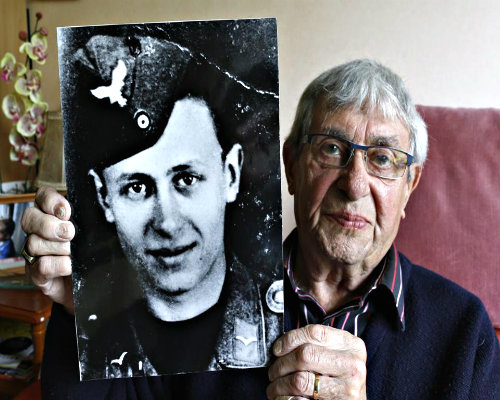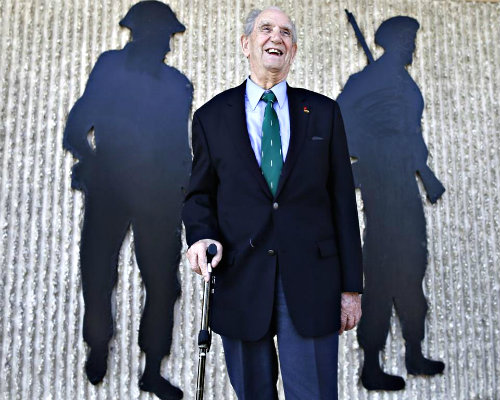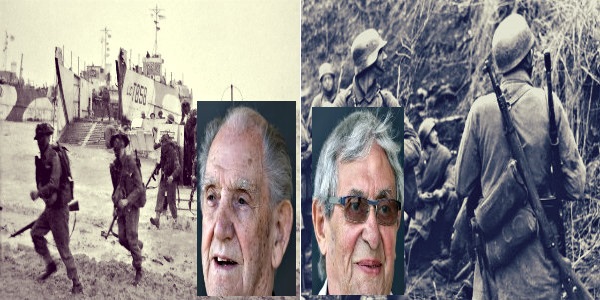When a friendship forms between two WWII soldiers who were ‘enemies’ – fighting in opposing sides – during the Second World War…
When French WWII commando Leon Gautier landed on Sword Beach as one of the first French commandos to set on foot on Sword Beach amidst a volley of fire from the enemy June 6, 1944, he never expected that seven decades later one of the enemies who fired at them that day would become his neighbor and eventually, a close friend.
Leon Gautier, now 91, lived in the French town where he landed on D-Day. He could still clearly remember that day when he set foot on the beach with a Tommy gun on hand. He had a year of training before he was shipped off to one of WWII’s major battles, the Normandy Landings. He was one of the 177 French soldiers under Phillip Kieffer, part of the No. 4 British Commando Unit who braved the shores of Sword Beach with its barbed wires and landmines while machine gun fire raged around them.
But it seemed history has a little sense of humor for putting him right next to one of the Germans who also fought at that time but in the “other side of the fence”, as Yahoo News reports.
Johannes Boerner, now 88 years old, was one of the German enemies fighting against the Allies during the landings in Normandy. He took up French citizenship in 1956 after he got married to a local Norman woman.
However, instead of riling up against each other and treating each other as enemies as things would have been seven decades ago, the French commando and the German parachutist who hailed from Leipzig have forged a bond made stronger by time and shared understanding of the Second World War.
Neighbors in the Normandy town of Ouistreham, the former “enemies” went on to celebrate Christmas together in 2012 and are planning on attending the coming 70th D-Day Anniversary this Friday, June 6.
As what Boerner pointed out, he and Gautier are like brothers now.
Their Stories

Gautier recalled how he was checking his ammunition cartridge and grenade shortly before landing on Sword Beach from a boat that was part of the unforgettable armada of sea crafts that day. he also had a picture of his wife, Dorothea, in his pocket which ‘got a little wet’, according to him, when jumped on the shore. He was able to fix it later, though, and is still carrying it with him until this day.
Even before they stepped on land, Gautier and his fellow commandos were greeted with shells from the German bunkers. However, the adrenaline coursing through them and the months of training overcame their fear for the enemies. Commander Kieffer has also reminded them beforehand of the possible things that would happen to them that day and one thing had pressed on to Gautier’s mind: the great possibility that not even 10 of them from the unit would come out alive.
350 kilometers away, Johannes Boerner was woken up from his sleep by an alarm “The Allied troops are landing in Normandy!”
Boerner along with the rest of the top notch 2nd Fallschirmjaeger (parachute) unit hiked on foot 350 kilometers to Normandy in a bid to strengthen German defenses against the enemies as well as attempt to destroy the Allied bridgehead.
Though the two men were not in the same place at the same time as the battle in Normandy raged on, they had matching memories of what went on around them — the horrendous smell of human corpses, both comrades and enemies, rotting; the impassable shrubberies that got tanks trapped and became a haven for snipers, the mosquitoes and their buzzes amidst the voices of the enemies just meters away and the small green apples that had been too sour to eat.

Boerner and his unit retreated to the interior after Americans closed on them on July 17 forcing them to abandon their fort at Saint-Lo. However, they got trapped in the ‘cauldron’ in the Battle of the Falaise Pocket. It was, to Boerner, the most horrible part of his memory about the war — being completely surrounded by the enemies with dead bodies seemingly everywhere.
Boerner along with his remaining comrades from other disbanded German units lost their morale, were ridden with lice and were hungry. They began searching through the pockets of dead soldiers for cigarettes and food. After days of aerial and artillery attacks – August 21 – Boerner got captured by the Canadians after failing to escape through a narrow passageway the Germans dubbed as the corridor of death.
He became a German POW and was forced into farm labor until 1947. However, he still considered himself lucky given that he was among the only nine in his original company’s 120 men to survive.
Gautier was also shipped back to Britain after fighting in Normandy for three months. From the 127 French commandos who participated in the skirmish, only 25 of them escaped death and wounding.
Living After WWII
Boerner decided to make a life at the place where he already was – in Normandy – after being released from the prison camp where he was incarcerated as the the city where he was from,Leipzig, were literally in ruins and was under Soviet control.
Gautier, on the other hand, went to several deployments in Britain, France and even Cameroon after his close call with the enemies at the Battle of Normandy. He then decided to permanently move to France and settle on a job as a claims adjuster. Upon retirement, he moved to Ouistreham where Boerner had a restaurant, the Chateaubriand.
It was here where the former “enemies” met and became friends.
A book about the two former-enemies-turned-friends WWI vets was written by Jean-Charles Stasi. Titled Ennemis et frères (Enemies and Brothers), the said book was published in 2010.
Both men may have fought in the two warring sides of WWII. But both totally agree that fighting as big as World War II shouldn’t happen again. Boerner find the idea of today’s young men taking up guns and shooting them horribly impossible.
“Our young people…they need to know all about this so it won’t happen again,” Gautier added.
